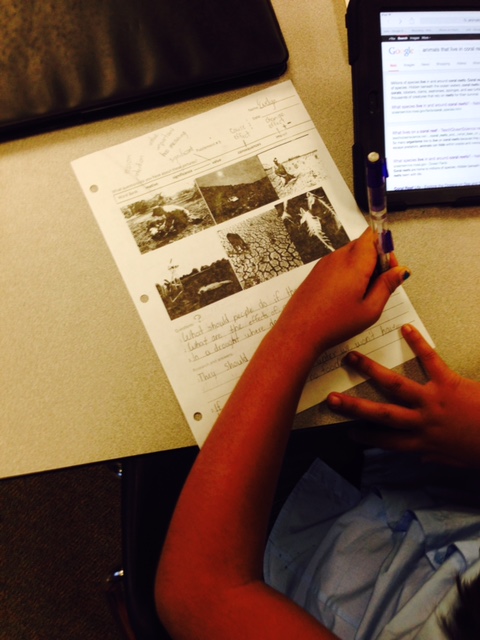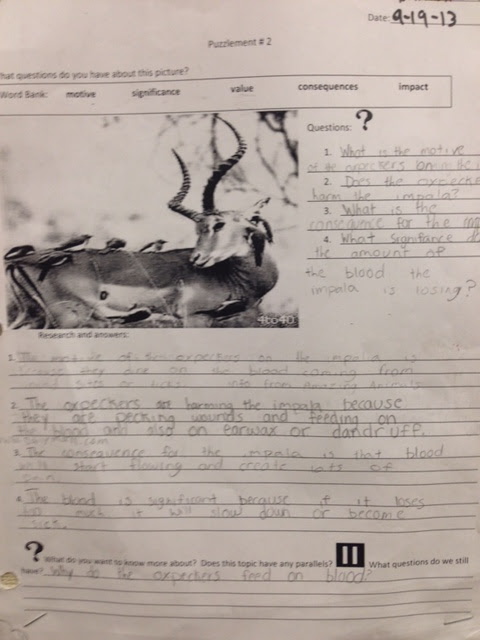While becoming GATE certified, I learned some really helpful and engaging strategies, activities, and ideas. One of these activities is called a Puzzlement, which is a form of group investigation. Students have to observe, analyze, question, research, and synthesize information during a puzzlement. I fell in love with puzzlements instantly! What made this form of group investigation even better is that I was able to tailor it to meet my students' needs.
How A Puzzlement's Done...
Ignite Questions:
Basically, you show your students either a picture, poem, illustration, phenomenon, math problem, video, a work of art, etc. that strikes interest and confusion at the same time. Students then pose questions about this topic (not knowing exactly what's going on). I like to record these questions on the Smartboard, so we have a nice list forming.
You then weed out the weak questions or questions that are completely off topic. You may be wondering which questions would be considered weak or off topic? Well, when I look for a puzzlement photo, I have to ponder about what I want my students to learn since they'll be researching this unknown phenomenon or situation. Therefore, if I put up a picture of animals and people involved in a drought, I may not want my students researching the phrase "the end of the world." In other words, sometimes you have to help steer your students' questions in the right direction. This is why you don't want your topic to be too vague, or you pose the risk of having students all over the place during your lesson (although this could be okay too if you're just having fun with the lesson). Here's an example below:
Above, you can see the puzzlement I mentioned about animals and people involved in droughts. This time I decided to use multiple pictures because I wanted my students to be on the right track with their research. I also knew we were going to be learning about how people can affect ecosystems, and we were also participating in a water poster contest about saving water, so I wanted my investigation to revolve around water.
Many times I use puzzlements to begin a new unit. This invokes curiosity about an unknown topic or an unanswered question, and now you have your students wanting to learn more and more about your upcoming learning objective.
Researching
After the questions are formed and chosen, students are now to investigate these questions in some way. I've done this several ways. We've used textbooks, posters in the room, laptops, and iPads. They're all sufficient, but the kids surely get a kick out of using technology. No technology in your room? If you have a computer lab, you could save the researching part for the lab. If you don't have any technology, you could use textbooks and articles off the internet. I know I mentioned using posters; I only used posters as a resource once when teaching the order of operations in math. I even had a song about PEMDAS (Please Excuse My Dear Aunt Sally--Parenthesis, Exponents, Multiplication, Division, Addition, Subtraction). It was really entertaining to watch kids explore around the room looking for clues. Here are some pictures:
I also allowed my students to work with a partner if they chose to do so. Before my class was given iPads, we shared a laptop cart between four classes. That cart didn't have enough laptops for each of my students to have his or her own, so I paired each student up with a partner. Students had to learn to take turns and work together to find what they were looking for. As you know, this is not always a dream scenario, but when I reminded students that they might lose their laptop if they're not following directions, they were VERY quick to get back on task! :)
Using the Prompts of Depth and Complexity & Content Imperatives
In the picture below, students had to figure out the significance and relationship between the oxpeckers and the impala. I thought this was a good way to lead into "Interactions of Living Things."
Great For All Ages...GATE or Not
I've since updated the organizer even more. The students go wild for puzzlements! Again, I've used these group investigations with GATE and general ed students, and they both LOVE it! I recently demoed a puzzlement in a 6th grade GATE class and the topic was on early man. The students used their textbooks one day to research and the internet the next. This was their first social studies topic of the new school year, so it was a good way to motivate them into wanting to learn more. We even used a video clip instead of pictures to get the questions started!
Discussion
After students are finished researching and arriving at their answers, a discussion should take place to highlight the new learning. This is a great time for those collaborative conversations! I've created a puzzlement organizer with no pictures on the top, so you can find your own pictures and paste them on. There's also a second organizer which doesn't leave room at the top, so you can post on the board instead (especially if it's not a photo). You can find my puzzlement organizer by clicking on the link below:
 https://www.teacherspayteachers.com/Product/GATE-Puzzlement-Group-Investigation-Activity-Organizer-1874532
https://www.teacherspayteachers.com/Product/GATE-Puzzlement-Group-Investigation-Activity-Organizer-1874532
Maybe you could even try this with a back to school discussion on learning and the brain!









No comments:
Post a Comment